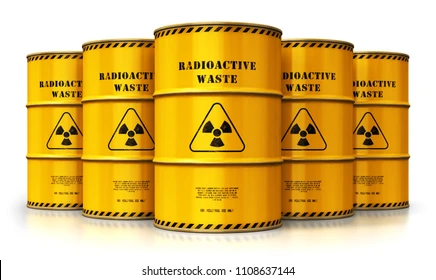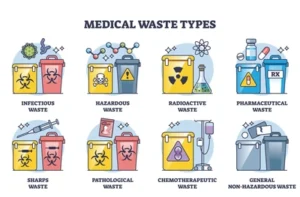
Introduction
- Handling aur disposal of infected aur dangerous radioactive materials ek highly specialized process hai, jisme strict safety protocols, legal regulations, aur industry standards ko follow karna padta hai.
- Radioactive materials, jo harmful radiation emit karte hain, agar sahi tareeke se manage na kiye jaye, to human health, wildlife, aur environment ke liye kaafi dangerous ho sakte hain.
- In materials ko safely handle karna aur dispose karna ka main goal yeh hota hai ki radiation exposure ko minimize kiya jaye, contamination roka jaye, aur public aur environmental safety ko ensure kiya jaye.
- Is process me kai important steps hote hain, jaise ki material ki risks ko pehle identify aur assess karna, safe handling ke liye appropriate shielding aur protective equipment ka use karna, designated facilities me secure storage, aur radioactive waste ka final disposal aise tareeke se karna jo environment se usko isolate kar sake long term tak.
- Regulatory bodies jaise International Atomic Energy Agency (IAEA) aur national agencies strict rules aur guidelines set karte hain taaki yeh practices follow ho sakein.
- Handling aur disposal of infected aur dangerous radioactive materials kaafi serious process hai, jisme strict safety guidelines, legal regulations aur industry standards ko follow karna padta hai.
- Isse human health, environment, aur materials ki safety ensure hoti hai.
- Yahan pe ek detailed breakdown diya gaya hai:
For English notes, click here
Preparation aur Risk Assessment
-
Hazard Identification: Radioactive materials ko handle karne se pehle, unke nature ko samajhna zaroori hai, jaise ki isotopic composition, radioactivity level, aur biological effects. Har radioactive isotope ka alag impact hota hai, jo handling aur disposal approach ko influence karta hai.
-
Example: Uranium-235 ya Plutonium-239 jaise isotopes kaafi highly radioactive hote hain aur long-term risks pose karte hain, jabki Carbon-14 ka risk kam hota hai kyunki uska half-life zyada hai.
-
-
Radiation Type: Radioactive materials alpha, beta, ya gamma radiation emit karte hain, aur har type ke liye alag safety measures chahiye hote hain.
-
Alpha particles sabse kam penetrate karte hain aur paper ya skin se rok jaate hain, lekin agar yeh inhale ya ingest kiya jaye to harmful ho sakte hain.
-
Beta particles skin ko penetrate kar sakte hain aur inke liye thoda zyada protection (e.g., plastic, glass) chahiye.
-
Gamma rays zyada penetrating hote hain aur inko shield karne ke liye lead ya concrete jese dense materials ki zaroorat hoti hai.
-
-
Risk Assessment Tools: Radiation detection tools (e.g., scintillation counters, Geiger counters) se radioactivity assess ki jati hai. Yeh risk assessment environmental contamination aur worker safety ko bhi evaluate karta hai.
Handling Radioactive Materials
-
Radiation Protection Standards: International Commission on Radiological Protection (ICRP) ke according, handling practices ALARA Principle (As Low As Reasonably Achievable) par focus karti hain, jiska goal hai radiation exposure ko minimize karna.
-
Shielding: Lead, concrete, aur steel jese materials ko radiation se protection ke liye use kiya jata hai. Shielding ka type aur thickness material ki radioactivity ke upar depend karta hai.
-
Personal Protective Equipment (PPE):
-
Lead aprons, gloves, aur face shields: Yeh external exposure se protect karte hain.
-
Respirators: Yeh radioactive dust ya gases ko inhale karne se protect karte hain.
-
Full-body suits: High contamination zones ya highly radioactive materials ke liye yeh suits use kiye jate hain.
-
-
Decontamination: Agar contamination hoti hai, to surfaces, clothing, ya equipment ko turant clean karna padta hai. Isme wet wipes, chemical decontaminants, aur special vacuum cleaners use kiye jate hain jo radioactive materials ko safely clean kar sake.
Transportation
-
Regulated Transport: Radioactive materials ko transport karte waqt international aur national regulations ko follow karna padta hai. International Atomic Energy Agency (IAEA) aur U.S. Department of Transportation (DOT) jaise authorities safe transport ke liye rules banati hain.
-
Packaging: Radioactive materials ko secure aur leak-proof containers me pack kiya jata hai jo regulations ko meet karte hain. Packaging ka type material ki radioactivity level ke hisaab se decide hota hai (Type A, Type B, etc.).
-
Type A packaging low-level radioactive materials ke liye hoti hai jo normal transport conditions me handle ki ja sakti hain.
-
Type B packaging zyada dangerous materials ke liye hoti hai jo accidents jaise car crashes ya plane crashes se bhi survive kar sake.
-
-
Transportation Vehicles: Special vehicles use kiye jate hain jo radioactive materials ko safely transport kar sake. In vehicles me radiation detection equipment bhi hota hai jo leakage ya exposure ko monitor karta hai.
-
Emergency Protocols: Agar transport ke dauran koi spill, accident, ya leakage hoti hai, to emergency procedures follow karna zaroori hota hai, jaise containment aur relevant authorities ko notify karna (fire aur police departments).
Storage of Radioactive Materials
-
Designated Storage Facilities: Radioactive materials ko specially designed facilities me store kiya jata hai jahan unki radioactivity ko control kiya jata hai aur public aur environment se isolate rakha jata hai.
-
Types of Storage:

-
Short-term Storage: Low-half-life radioactive materials ke liye short-term storage use kiya jata hai, jisme shielded containers ya vaults hote hain.
-
Long-term Storage: High-level radioactive waste (e.g., spent nuclear fuel) ko deep geological repositories me store kiya jata hai jo surface se hundreds of meters deep hote hain.
-
-
Monitoring: Storage areas me continuous radiation monitoring systems hone chahiye jo leakage ya exposure ko detect kar sake. Regular inspections bhi karni padti hain taaki containers aur shielding ki integrity maintain rahe.
-
Access Control: Sirf authorized personnel ko storage areas me access milni chahiye, aur unka access monitor aur log kiya jana chahiye.
Disposal of Radioactive Materials
-
Waste Classification: Radioactive waste ko unke radioactivity levels ke hisaab se classify kiya jata hai:
-
Low-Level Waste (LLW): Contaminated gloves, clothing, aur paper jese materials. Inhe thodi der ke liye store karne ke baad, decay karne diya jata hai aur phir landfill me dispose kiya jata hai.
-
Intermediate-Level Waste (ILW): Reactor components ya chemical sludge jese items. Inhe storage aur disposal ke dauran shielding ki zaroorat hoti hai.
-
High-Level Waste (HLW): Spent nuclear fuel ya kaafi radioactive materials. HLW ko specially designed containers ya deep geological storage me store kiya jata hai.
-
-
Decay Storage: Short-lived isotopes (jinke half-lives chhote hote hain) ke liye decay storage ka option hota hai. Isme material ko secure aur controlled environment me store kiya jata hai jahan time ke saath radiation level kam hota hai.
-
Incineration aur Burial: Kuch radioactive materials, jaise medical ya industrial waste, ko incinerate kiya jata hai (specialized facilities me) taaki volume kam ho sake aur phir burial kiya jata hai landfill me jo radioactive waste ko contain kar sake.
-
Geological Disposal: High-level waste ko deep geological formations me dispose kiya jata hai. Yeh deep underground stable rock formations me store kiya jata hai taaki waste surface tak na aaye aur radiation ko isolate kiya ja sake.
Environmental aur Health Monitoring
-
Radiation Surveys: Radiation surveys regularly conduct kiye jate hain taaki yeh ensure kiya ja sake ki radioactive materials containment me hain aur radiation levels safe hain.
-
Environmental Monitoring: Surrounding air, water, aur soil ko regularly monitor kiya jata hai storage aur disposal sites ke aas-paas, taaki contamination detect ho sake.
-
Health Surveillance of Workers: Workers jo radioactive materials handle karte hain, unka regular medical checkup hota hai, jaise whole-body scans aur blood tests, taaki early signs of radiation exposure detect kiya ja sake. Dosimeters bhi wear kiye jate hain taaki accumulated radiation dose track ho sake.
Regulatory Compliance
-
National Regulations: Har country ka apna regulatory authority hota hai radioactive materials ko control karne ke liye. U.S. me Nuclear Regulatory Commission (NRC) aur Environmental Protection Agency (EPA) nuclear safety aur environmental protection oversee karte hain.
-
International Regulations: International Atomic Energy Agency (IAEA) global standards aur recommendations provide karti hai radioactive materials ke safe handling, transport, aur disposal ke liye. IAEA guidelines ka follow karna zaroori hota hai jab international transport aur trade hota hai.
-
Records aur Documentation: Radioactive materials ke handling, transportation, storage aur disposal ke har stage pe detailed records maintain karna padta hai. Yeh records audits, legal compliance, aur material ke lifecycle ko track karne ke liye zaroori hote hain.